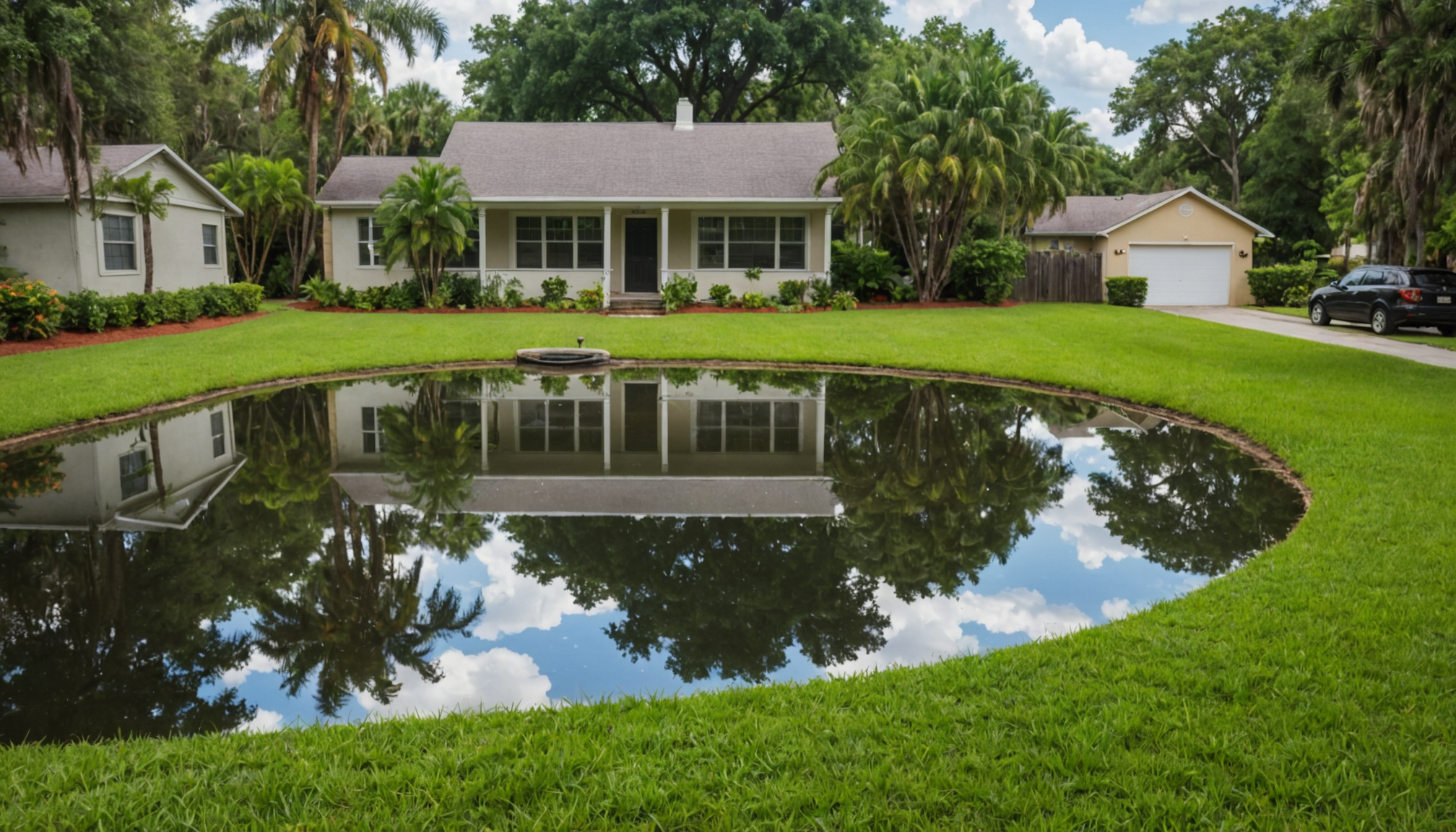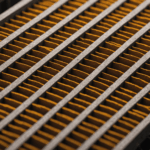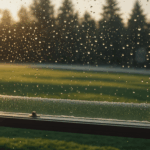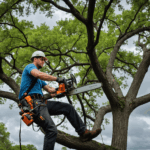Tampa’s unique combination of heavy seasonal rainfall, high water table, and clay-rich soils creates significant drainage challenges for homeowners. According to the National Weather Service, Tampa receives an average of 46 inches of rainfall annually, with nearly 60% occurring during the summer months, leading to several common yard drainage issues that require immediate attention.
Standing water, or pooling, is particularly problematic in Tampa yards, especially in areas where the natural grade has been altered during construction. The University of Florida Extension Service reports that approximately 65% of residential properties in Tampa experience some form of water accumulation after moderate to heavy rainfall. This standing water not only damages grass and plants but also creates perfect breeding grounds for mosquitoes and can compromise foundation integrity.
Another prevalent issue is soil erosion, which affects nearly 40% of Tampa properties, particularly those with slopes or inadequate drainage systems. The combination of sandy topsoil and clay subsoil common in Tampa makes properties especially vulnerable to erosion during heavy downpours.
- Saturated soil zones near house foundations
- Water pooling in lawn depressions
- Flooding in flower beds and gardens
- Overflow from neighboring properties
- Clogged or insufficient drainage systems
French drain failures are increasingly common in older Tampa neighborhoods, where systems installed 15-20 years ago have become clogged with sediment and root infiltration. The Florida Association of Landscape Contractors estimates that nearly 30% of existing French drains in Tampa require significant repair or replacement due to improper installation or maintenance.
Grading issues represent another significant challenge, with many Tampa properties showing improper slope directions that channel water toward structures instead of away from them. Professional surveys indicate that approximately 45% of Tampa homes have grading problems that contribute to poor drainage, often resulting from natural soil settlement or improper initial construction grading.
During Tampa’s rainy season, these problems become particularly evident in areas with high clay content soils, which can be found in neighborhoods like Carrollwood, Temple Terrace, and parts of South Tampa. These clay-rich soils typically drain at rates 70% slower than sandy soils, according to studies by the Tampa Bay Water Management District.
Best materials for Tampa drainage systems
When selecting materials for drainage systems in Tampa’s challenging climate, durability and performance under extreme conditions are paramount. High-density polyethylene (HDPE) pipes have emerged as the leading choice for French drain installations, offering superior resistance to Florida’s intense UV radiation and maintaining structural integrity despite temperature fluctuations. These pipes typically last 30-50 years when properly installed and maintained.
Permeable pavers have gained significant popularity in Tampa’s residential areas, demonstrating excellent drainage capabilities while withstanding heavy vehicle traffic. These pavers allow water to penetrate through joints filled with specialized aggregate, reducing surface runoff by up to 70% compared to traditional concrete surfaces.
Geotextile fabric is essential for Tampa drainage systems, particularly in areas with sandy soil. This material prevents soil particles from clogging drainage pipes while allowing water to pass through freely. Professional contractors in Tampa recommend using non-woven geotextile fabric with a minimum weight of 4 ounces per square yard for optimal performance.
Gravel selection is crucial for effective drainage in Tampa’s climate. Angular stones, typically #57 limestone or granite, provide better water flow and stability compared to rounded river rock. The Tampa Water Management District recommends using clean, washed stone to prevent fine particles from compromising system efficiency.
For surface drainage channels, polymer-based trench drains have proven highly effective in Tampa’s environment. These modern materials resist corrosion from salt exposure and withstand the intense heat and UV radiation typical of Florida summers, offering a significant advantage over traditional concrete channels.
- HDPE pipes demonstrate 40% better longevity than PVC in Tampa’s climate
- Permeable pavers with proper aggregate can handle up to 450 inches of rain per hour
- Non-woven geotextile fabric prevents up to 95% of soil infiltration in drainage systems
Professional vs DIY drainage solutions
Many homeowners in Tampa attempt to tackle drainage projects themselves, but without proper knowledge and equipment, these DIY efforts can lead to costly mistakes. A common error is installing French drains at incorrect depths – professional contractors consistently find that DIY installations are typically 4-6 inches too shallow, resulting in system failure during heavy Florida rains.
Installing drainage systems without proper permits is another frequent mistake that can result in fines and mandatory system removal. Tampa’s building codes require permits for any drainage work that alters the property’s natural water flow, particularly in flood-prone areas.
While DIY solutions might seem cost-effective initially, professional installations often prove more economical long-term. Local drainage contractors report that approximately 60% of their service calls involve fixing failed DIY attempts, with repairs costing 30-40% more than a professional installation would have originally.
However, some drainage projects are suitable for DIY approaches. Simple solutions like installing splash blocks, cleaning gutters, or creating small swales can be effectively handled by homeowners. For these projects, success rates increase significantly when proper research and planning are conducted beforehand.
Professional contractors bring several advantages to drainage projects:
– Access to specialized equipment for accurate grading and elevation measurements
– Knowledge of local soil conditions and water table characteristics
– Understanding of Tampa’s complex permitting requirements
– Ability to coordinate with utility companies for underground service locations
– Warranty coverage for installed systems
DIY projects are more appropriate for:
– Minor grading adjustments around downspouts
– Installation of above-ground drainage extensions
– Creation of small rain gardens
– Basic maintenance of existing drainage systems
The decision between professional and DIY often depends on project scope. Projects involving significant grading changes, underground pipe networks, or areas larger than 200 square feet typically require professional expertise to ensure proper functionality and compliance with local regulations.
Maintenance tips for yard drainage
Regular maintenance is crucial for keeping drainage systems functioning optimally in Tampa’s challenging climate. A well-maintained system can extend its lifespan by 15-20 years and prevent costly repairs or replacements. Implementing a consistent maintenance schedule, especially before and after Tampa’s rainy season, ensures maximum system efficiency.
Quarterly inspections of drainage components should include:
– Checking for debris accumulation in catch basins and grates
– Examining French drain outlets for proper water flow
– Assessing grading changes that might affect drainage patterns
– Inspecting for root intrusion in underground pipes
– Monitoring erosion around drainage structures
Clean gutters and downspouts at least three times annually, with additional checks during Tampa’s heavy leaf-falling periods. This simple task prevents overflow that can compromise ground-level drainage systems. Use a garden hose to test downspout function and identify any potential blockages.
For French drain maintenance, consider these essential practices:
– Flush the system annually with pressurized water
– Remove sediment from collection boxes every six months
– Trim roots near drainage pipes to prevent infiltration
– Replace filter fabric if signs of deterioration appear
– Clear surface grates monthly during growing seasons
Yard grading requires regular attention to maintain proper drainage slopes. Check for settling or erosion that might create low spots where water can collect. Add soil to these areas to maintain the recommended 1-inch drop per 10 feet away from structures.
Professional hydro-jetting services every 2-3 years can prevent severe clogging in underground drainage pipes. This maintenance method is particularly effective in Tampa’s sandy soil conditions, where fine particles can gradually accumulate within the system.
Vegetation management plays a crucial role in drainage maintenance:
– Keep grass trimmed around drain covers and outlets
– Remove invasive root systems near drainage structures
– Maintain proper plant spacing to prevent soil compaction
– Use appropriate ground cover to minimize erosion
Document all maintenance activities and system performance during heavy rains. This record-keeping helps identify patterns and potential issues before they become serious problems. Take photos during inspections to track changes over time and maintain a detailed maintenance log.
By following these maintenance protocols, homeowners can significantly reduce the risk of drainage failures and extend the life of their systems. Remember that prevention through regular maintenance is far more cost-effective than emergency repairs during Tampa’s intense rainy seasons.
Cost-effective drainage improvements
- How much does it typically cost to fix drainage issues in Tampa?
- Basic drainage solutions in Tampa can range from $500 to $2,000 for simple surface modifications. More complex systems, such as French drains or complete yard regrading, typically cost between $2,500 and $8,000, depending on property size and specific requirements.
- Can I save money by installing drainage systems in stages?
- Implementing drainage solutions in phases can be cost-effective, but it requires careful planning to ensure each stage works cohesively with future additions. Start with critical areas near the foundation and gradually expand the system as budget allows, while maintaining a comprehensive drainage plan.
- What’s the most affordable way to prevent water pooling in my Tampa yard?
- Surface grading adjustments and strategic placement of downspout extensions are among the most cost-effective solutions, typically costing $200-$500. Creating simple swales or drainage ditches can effectively direct water away from problem areas without significant expense.
- Should I invest in permeable pavers or stick with traditional concrete for my driveway?
- While permeable pavers have a higher initial cost ($15-20 per square foot), they can save money long-term by reducing the need for additional drainage systems. Traditional concrete ($8-12 per square foot) might require supplementary drainage solutions, potentially making it more expensive overall.
- How can I maintain my drainage system without spending a lot on professional services?
- Regular DIY maintenance like clearing debris from drains, cleaning gutters, and maintaining proper grading can significantly reduce professional service needs. Invest in basic tools like a drain snake ($20-50) and pressure washer attachment ($30-75) for routine maintenance tasks.











